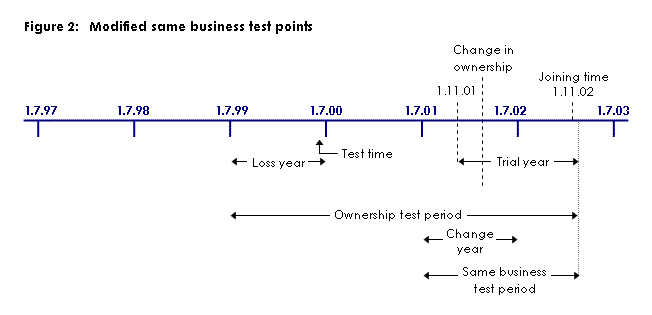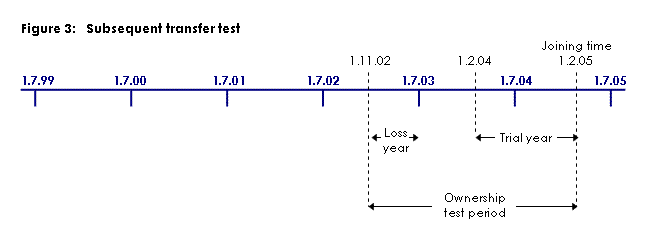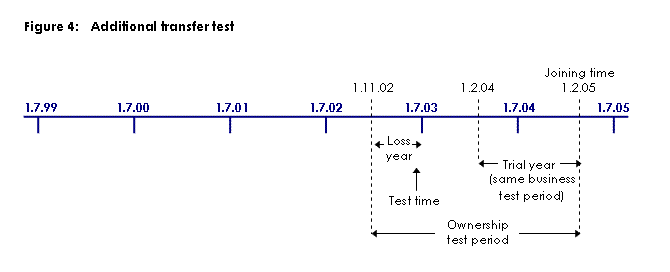Consolidation Reference Manual
You can still refer to the Consolidation reference manual for consolidation information that has not been impacted by changes in the legislation.
C3 Losses
C3-3 Worked example - loss transfer
Transfer testing
C3-3-250 Additional test for second or subsequent transfer of a loss previously transferred because the SBT was passed
Description
If, by a previous operation of Subdivision 707-A, a loss had been transferred to a joining entity because the entity from which the loss was previously transferred met the same business test, the loss will not be transferred from the joining entity to the head company unless it satisfies an additional test. This example shows how the additional test applies.
Commentary
Section 707-135 introduces an additional test that must be satisfied in order to transfer a loss. Essentially, the joining entity must satisfy the same business test (section 165-210) for the trial year (the same business test period) and the time (the test time) just before the end of the income year in which the loss was transferred to the joining entity.
Example
Facts
A consolidatable group acquires 100% of the equity in a joining entity (a company) on 1 August 2002. A pre-1 July 1999 tax loss of the joining entity is transferred on the basis of satisfying the same business test at the joining time of 1 November 2002 when the group consolidates.
Subsequently - on 1 February 2005 - the head company of the consolidated group becomes a subsidiary member of another consolidated group. The second head company requires only a 5% acquisition to obtain 100% ownership of the first head company. None of the loss has been utilised by the first head company.
Calculation
Step 1: First head company trial year testing - same business test as a transfer test
The first step is to show how the loss was transfer tested at the first joining time (that is, 1 November 2002) as a result of the ownership failure (under section 165-12) emanating from the acquisition of the joining entity on 1 August 2002.
The recoupment test of section 165-13 was relied on for transfer testing. As the loss tested is a pre-1 July 1999 loss, the modified same business test in section 707-125 did not apply.

As the loss transfer occurred 'because the entity from which the loss was transferred carried on during a particular period the same business as it carried on at a particular time' ( → subsection 707-135(2)) the loss is 'tagged' as a loss that will always be subject to the additional test if transferred again.
Step 2: Effect of transfer for first head company
The effect of the transfer of the loss from the joining entity to the head company is to treat the loss, for the purposes of income years ending after the transfer, as if the head company had made the loss for the income year in which the transfer occurs. → subsection 707-140(1)
Thus, as shown in the illustration below, the head company is treated as having made the loss for the 2003 income year and is not prevented from utilising it in that year. → section 707-140(2)

The loss is now designated a loss in respect of the 2003 income year of the head company. The loss is able to be utilised by the head company for the 2003 and subsequent income years on a section 165-12 basis of recoupment, unless there is an ownership or control failure that then forces it to test on a section 165-13 basis.
Step 3: Second head company trial year testing - ownership and control transfer tests
However, on 1 February 2005 the head company itself becomes a subsidiary member of a consolidated group through its parent (the second head company) acquiring the outstanding 5% equity to give 100% ownership. The loss on hand in the first head company is now subject to the transfer testing process in section 707-120.
As shown in figure 3, the loss would appear to satisfy the ownership and control transfer test; that is, there is no failure in the ownership test period from the beginning of the loss year through to the joining time (note the effect of section 707-205 to bring the start of the loss year in line with the transfer time). Normally, this would be sufficient for the loss to be transferred to the second head company (for example, if the loss were instead a group loss rather than a transferred loss of the first head company).

Step 4: Second head company trial year testing - additional transfer test
However, as the loss was previously transferred to the first head company because the original loss-maker carried on during a particular period the same business as it carried on at a particular time, the additional transfer test must be applied. If the loss could not be transferred because the usual tests applied under section 707-120 were failed, there would be no reason to apply the additional test: the additional test, by itself, cannot facilitate the transfer of a loss.
The additional test would apply as shown in figure 4.

Thus, not only does a section 707-120 transfer test need to be satisfied; so also does the section 707-135 test. The first head company needs to meet the same business test in respect of the testing points - that is, the trial year and the test time (being just before the end of the loss year).
Outcome
On the basis that the same business test was met in respect of these relevant times, the loss is transferred to the second head company.
If it cannot be transferred, its utilisation will be restricted in accordance with section 707-150 - that is, it cannot be used by any entity for the 2005 and later income years.
References
Income Tax Assessment Act 1997 sections 165-210 , 165-12
Income Tax Assessment Act 1997 - as amended by:
- •
-
New Business Tax System (Consolidation) Act (No. 1) 2002
(No. 68 of 2002), Schedule 1:
- -
- subsections 707-120(1) , 707-120(3)
- -
- sections 707-125 , 707-135
- -
- subsections 707-135(2) , 707-140(1) , 707-140(2)
- -
- sections 707-150 , 707-205
- •
-
Taxation Laws Amendment Act (No. 5) 2003
(No. 142 of 2003):
Explanatory Memorandum to the New Business Tax System (Consolidation) Bill (No. 1) 2002, Chapter 6
History
Revision history
Section C3-3-250 first published (excluding drafts) 2 December 2002.
Further revisions are described below.
| Date | Amendment | Reason |
|---|---|---|
| 5.4.04 | 'Continuity period' removed from figure 1. | Reflect changes in Taxation Laws Amendment Act (No. 5) 2003 (No. 142 of 2003). |
Proposed changes to consolidation
Proposed changes to consolidation announced by the Government are not incorporated into the Consolidation reference manual until they become law. In the interim, information about such changes can be viewed at:
- •
- http://assistant.treasurer.gov.au (Assistant Treasurer's press releases)
- •
- www.treasury.gov.au (Treasury papers on refinements to the consolidation regime).
Current at 5 April 2004
